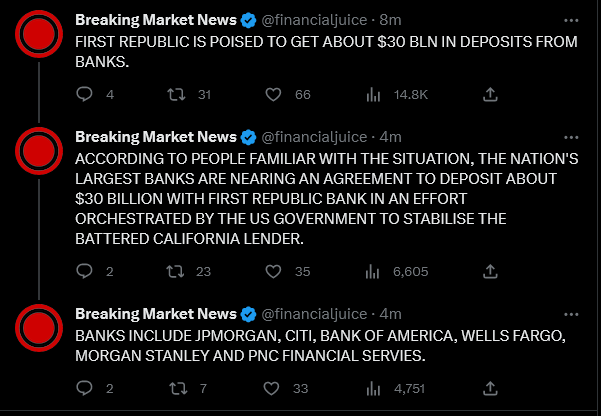Palaten vielä tuohon jenkkien pienten pankkien ongelmaan nykytilanteessa nämä kuvaajat havainnollistavat hyvin kuinka FEDin QT on osunut toistaiseksi paljon kovempaa pienten pankkien taseisiin.
Lähde:
March 2023 Newsletter: A Look at Bank Solvency - Lyn Alden
Pienten pankkien osalta ollaan jo samalla tasoilla kuin 2019 syksyn repo piikin aikaan. Pienet pankit kohtaavat tässä ympäristössä monista eri suunnista vastatuulta. Täälläkin monen tuntema Macro Alf avaa hyvin tuota dynamiikkaa tässä jutussa: Reactions to Silicon Valley Bank meltdown | Reuters
"This (banks which will be forced to sell available-for-sale securities at a loss) is much less of an issue at large banks because they have stronger balance sheets and they can repo securities out rather than selling them outright. Moreover, AFS bonds (unrealized) losses are already accounted for in the bank’s capital position, so much more disclosed than HTM unrealized losses. Selling these bonds would crystallize losses through the P&L but would be much less of a surprise.
Smaller banks are more affected. Reserves at small banks have declined much faster than at large banks and the competition for retail deposits from T-bills and MMF yielding almost 5% weights on small banks much more than large banks, which have a more diversified funding base.
I expect banks to buy less Treasuries overall, and this has been the case already for months. There are less reserves around due to the Fed’s QT and that changes the incentive schemes for banks - it makes them less aggressive when looking for bonds to buy."
Tähän kun vielä yhdistää pahasti kääntyneen korkokäyrän, niin ei ole pienillä pankeilla helppoa. Talletuskorkoa voitaisiin yrittää nostaa houkutellaakseen tallettajia pysymään pankille uskollisina, mutta tämä ohentaisi entisestään pankin marginaaleja. Tähän vielä tuo psykologinen vaikutus ihmisillä jossa epäluulo on varmasti nyt suurempi pieniä pankkeja kohtaan tämän SVB saagan jälkeen ja halutaan ehkä senkin kautta varmuuden vuoksi siirtää varoja isojen “too big to fail” pankkien holveihin.
Tässä vielä kuvaaja isojen pankkien reserveistä vertailukohdaksi:
Pienten pankkien määrä on vähentynyt jenkeissä 70-luvulta lähtien.
In 1971, according to FDIC, there were 13,612 banks in the country with 23,336 branches. Fifty years later, in 2021, there were only 4,237 banks with 72,405 branches. Although the population increased and the number of branches increased (not to mention all of the online banking that the industry shifted wards), the number of separate banks dropped dramatically and consolidated into fewer, larger ones. And even those statistics understate the level of concentration; in 2022 the top ten banks alone had approximately half of all bank assets, with the other 4,200+ banks combined holding the other half. Lähde: March 2023 Newsletter: A Look at Bank Solvency - Lyn Alden
Lyn Alden povaakin, että jos FED jatkaa nykytiellä, lisää pienempiä pankkeja ajautuu ongelmiin.
If the Federal Reserve does continue to push forward by raising interest rates and performing quantitative tightening, the long tail of small and medium-sized banks are at risk of ongoing liquidity drains, starting with the most vulnerable and moving up from there. If the small banks sharply raise interest rates to keep deposits, then they risk getting into solvency problems. The beneficiaries of this flight to safety would most likely be several of the the largest banks and money market funds.
The more the Federal Reserve tries to push interest rate increases and quantitative tightening in this business cycle, the more they will likely benefit the mega-cap J.P. Morgan Chase’s of the world over the small community banks, as reserves will likely continue to drain out of the smaller banks and threaten their liquidity profiles. The Federal Reserve’s BTFP on its own won’t prevent this process; it just make the liquidity drain out of small banks less disorderly.
Voi siis olla että pienten pankkien ongelmat eivät olleet vielä tässä ja lisää on luvassa. Aikamoinen himmeli alkaa FEDilläkin olla pitää kaikki narut käsissä, jos inflaatio ei rupea taittumaan niin pitäisi nostaa edelleen korkoja ja jatkaa QT:ta, mutta samaan aikaan pitäisi pitää nämä pankit jotenkin pystyssä 









